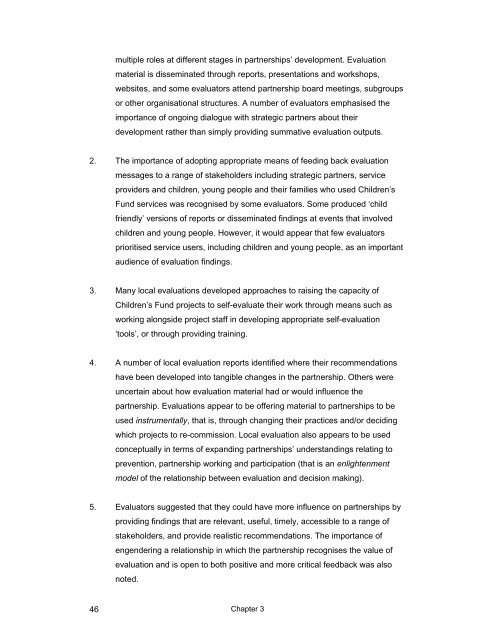Local Evaluation of Children's Services Learning from the Children's ...
Local Evaluation of Children's Services Learning from the Children's ...
Local Evaluation of Children's Services Learning from the Children's ...
- No tags were found...
Create successful ePaper yourself
Turn your PDF publications into a flip-book with our unique Google optimized e-Paper software.
multiple roles at different stages in partnerships’ development. <strong>Evaluation</strong>material is disseminated through reports, presentations and workshops,websites, and some evaluators attend partnership board meetings, subgroupsor o<strong>the</strong>r organisational structures. A number <strong>of</strong> evaluators emphasised <strong>the</strong>importance <strong>of</strong> ongoing dialogue with strategic partners about <strong>the</strong>irdevelopment ra<strong>the</strong>r than simply providing summative evaluation outputs.2. The importance <strong>of</strong> adopting appropriate means <strong>of</strong> feeding back evaluationmessages to a range <strong>of</strong> stakeholders including strategic partners, serviceproviders and children, young people and <strong>the</strong>ir families who used Children’sFund services was recognised by some evaluators. Some produced ‘childfriendly’ versions <strong>of</strong> reports or disseminated findings at events that involvedchildren and young people. However, it would appear that few evaluatorsprioritised service users, including children and young people, as an importantaudience <strong>of</strong> evaluation findings.3. Many local evaluations developed approaches to raising <strong>the</strong> capacity <strong>of</strong>Children’s Fund projects to self-evaluate <strong>the</strong>ir work through means such asworking alongside project staff in developing appropriate self-evaluation‘tools’, or through providing training.4. A number <strong>of</strong> local evaluation reports identified where <strong>the</strong>ir recommendationshave been developed into tangible changes in <strong>the</strong> partnership. O<strong>the</strong>rs wereuncertain about how evaluation material had or would influence <strong>the</strong>partnership. <strong>Evaluation</strong>s appear to be <strong>of</strong>fering material to partnerships to beused instrumentally, that is, through changing <strong>the</strong>ir practices and/or decidingwhich projects to re-commission. <strong>Local</strong> evaluation also appears to be usedconceptually in terms <strong>of</strong> expanding partnerships’ understandings relating toprevention, partnership working and participation (that is an enlightenmentmodel <strong>of</strong> <strong>the</strong> relationship between evaluation and decision making).5. Evaluators suggested that <strong>the</strong>y could have more influence on partnerships byproviding findings that are relevant, useful, timely, accessible to a range <strong>of</strong>stakeholders, and provide realistic recommendations. The importance <strong>of</strong>engendering a relationship in which <strong>the</strong> partnership recognises <strong>the</strong> value <strong>of</strong>evaluation and is open to both positive and more critical feedback was alsonoted.46Chapter 3
















